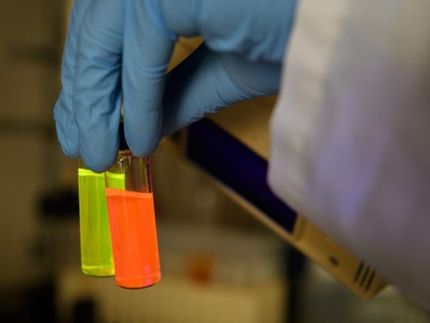Carnegie Mellon researchers create fluorescent biosensor to aid in drug development
Researchers at Carnegie Mellon University have developed a new fluorescent biosensor that could aid in the development of an important class of drugs that target a crucial class of proteins called G protein-coupled receptors (GPCRs).
"Drugs that target GPCRs make up approximately 30 percent of all pharmaceuticals currently on the market, including some of the most prescribed drugs," said Jonathan Jarvik, the Carnegie Mellon professor who led the effort to develop the GPCR biosensor. "This prevalence makes assays for the receptors a billion dollar industry."
GPCRs are popular drug targets because of the pivotal role they play in cells' chemical communication circuits that are responsible for regulating functions critical to health, including circuits involved in heart and lung function, mood, cognition and memory, digestion and the inflammatory response. Found in the cell membrane, GPCRs interact with molecules responsible for cellular communication such as neurotransmitters and hormones. When one of the receptors encounters such a molecule, it relays a signal across the cell membrane that, in turn, initiates a response. After the response is triggered, the receptor retreats from the membrane into the cell's interior.
To create the GPCR biosensor, the research team used a new technology called fluoromodules. Invented by Carnegie Mellon's Molecular and Biosensor Imaging Center (MBIC), fluoromodules are probes that allow scientists to monitor the activities of individual proteins found in living cells in real-time. The probes are made up of two components: a fluorogen-activating protein (FAP) and a non-fluorescent dye called a fluorogen. The FAP is attached to the protein that is being studied, and the fluorogen is engineered to bind to the FAP. When the two meet, they cast off a glow that can be detected using a variety of methods, alerting researchers to the protein's location and activity. The FAP's fluorescence can be turned on and off by adding or removing the fluorogen, a characteristic that makes the fluoromodules more useful than other fluorescent proteins.
In the current study, which is published in the July issue of the Journal of Biomolecular Screening, Jarvik and colleagues engineered a fluoromodule that would readily determine when GPCR retreats from the cell membrane. The researchers genetically expressed a FAP fused to the beta2 adrenergic receptor (beta2AR), a well-studied GPCR that is present in brain, heart, lung and other tissues. When the researchers introduced its associated membrane-impermeant fluorogen, it bound to the FAP-tagged GPCR on the cell surface, emitting a bright fluorescent glow. When the receptor was activated and had retreated into the cell, the fluorescence dimmed.
The new biosensor is notable, Jarvik said, because it looks directly at the receptor and provides what is known as a homogeneous, or mix-and-read, assay that can be scaled to screen large numbers of molecules to identify new drug leads.
The researchers are hopeful that this technology can be generalized across other receptors and cell-surface proteins, and are currently researching its broader applications.
Topics
Organizations
Other news from the department science
These products might interest you

Kjel- / Dist Line by Büchi
Kjel- and Dist Line - steam distillation and Kjeldahl applications
Maximum accuracy and performance for your steam distillation and Kjeldahl applications

AZURA Purifier + LH 2.1 by KNAUER
Preparative Liquid Chromatography - New platform for more throughput
Save time and improve reproducibility during purification

Get the analytics and lab tech industry in your inbox
By submitting this form you agree that LUMITOS AG will send you the newsletter(s) selected above by email. Your data will not be passed on to third parties. Your data will be stored and processed in accordance with our data protection regulations. LUMITOS may contact you by email for the purpose of advertising or market and opinion surveys. You can revoke your consent at any time without giving reasons to LUMITOS AG, Ernst-Augustin-Str. 2, 12489 Berlin, Germany or by e-mail at revoke@lumitos.com with effect for the future. In addition, each email contains a link to unsubscribe from the corresponding newsletter.





















































